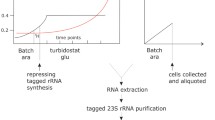Summary
Derivatives of isogenic stringent (relA +) and relaxed (relA) strains of Escherichia coli were compared in respect of rates of the dissociation of peptidyl-tRNA from ribosomes during protein synthesis. The derivatives both contained a mutant pth gene which rendered temperature-sensitive their peptidyl-tRNA hydrolase (E.C. 3.1.1.29) activities. After shifting from permissive 30° C to non-permissive 40° C, dissociated peptidyl-tRNA accumulated and was assayed chemically or by its cytotoxic effects. In unperturbed (except for the temperature shift) cultures the relA strain accumulated peptidyl-tRNA significantly more slowly than did its relA + isogenic cousin. Both strains responded approximately equally to non-lethal doses of erythromycin or to starvation for amino acids. Both these perturbations enhanced the dissociation and accumulation of peptidyl-tRNA. While growing at 30° C, both strains responded significantly to a nutritional downshift from growth in medium containing glucose plus amino acids to growth in medium containing only amino acids. Taken together the results suggested that different intracellular concentrations of ppGpp in unperturbed cells, attributable to the different relA alleles, could account for the differences in dissociation and accumulation of peptidyl-tRNA. Our observation of a lower rate of dissociation of peptidyl-tRNA in the relA strain, coupled with the reported lower intracellular ppGpp and lower accuracy of protein synthesis, is consistent with the idea that relA strains have less efficient ribosomal editing of erronous peptidyl-tRNA.
Similar content being viewed by others
References
Atherly AG, Menninger JR (1981) Mutant E. coli strain with temperature sensitive peptidyl-transfer RNA hydrolase. Nature (Lond) New Biol 240:245–246
Cabanãs MJ, Modolelle J (1981) Nonenzymic translocation and spontaneous release of noncognate peptidyl transfer RNA from Escherichia coli ribosomes. Biochemistry 20:5411–5416
Caplan AB, Menninger JR (1979) Tests of the ribosomal editing hypothesis: Amino acid starvation differentially enhances the dissociation of peptidyl-tRNA from the ribosome. J Mol Biol 134:621–637
Cashel M, Gallant J (1969) Two compounds implicated in the function of the RC gene of Escherichia coli. Nature (Lond) 221:838–841
Cuzin F, Kretchmer N, Greenberg RF, Hurwitz R, Chapeville F (1967) Enzymatic hydrolysis of N-substituted aminoacyl-tRNA. Proc Natl Acad Sci USA 58:2079–2086
Ferscht A (1981) Enzymic editing mechanisms and the genetic code. Proc Roy Soc (Lond) B Biol Sci 212:351–380
Gallant JA (1979) Stringent control in E. coli. Annu Rev Genet 13:393–415
Gallant J, Lazzarini RA (1976) The regulation of ribosomal RNA synthesis and degradation in bacteria. In: McConkey EH (ed) Protein synthesis, a series of advances, vol 2. M Dekker, New York, pp 309–359
Gallant J, Shell L, Bittner R (1976) A novel nucleotide implicated in the response of E. coli to energy source downshift. Cell 7:75–84
Hall B, Gallant J (1972) Defective translation of RC− cells. Nature (Lond) New Biol 237:131–135
Inoue-Yokosawa N, Ishikawa C, Kaziro Y (1974) The role of guanosine triphosphate in translocation reaction catalysed by elongation factor G. J Biol Chem 249:4321–4323
Jost J-P, Bock RM (1969) Enzymatic hydrolysis of N-substituted aminoacyl transfer ribonucleic acid in yeast. J Biol Chem 244:5866–5873
Kössel H, RajBhandary UL (1968) Studies on polynucleotides: LXXVI. Enzymatic hydrolysis of N-acyl-aminoacyl-transfer RNA. J Mol Biol 35:539–560
Kurland CG (1980) On the accuracy of translation. In: Chambliss G, Craven GR, Davies J, Davis K, Kahan L, Nomura M (eds) Ribosomes, structure, function and genetics. University Park Press, Baltimore, pp 597–614
Menninger JR (1976) Peptidyl transfer RNA dissociates during protein synthesis from ribosomes of Escherichia coli. J Biol Chem 251:3392–3398
Menninger JR (1977) Ribosome editing and the error catastrophe hypothesis of cellular aging. Mech Aging Dev 6:131–142
Menninger JR (1978) The accumulation as peptidyl-transfer RNA of isoaccepting transfer RNA families in Escherichia coli with temperature-sensitive peptidyl-transfer RNA hydrolase. J Biol Chem 253:6808–6813
Menninger JR (1979) Accumulation of peptidyl tRNA is lethal to EScherichia coli. J Bacteriol 137:694–696
Menninger JR, Mulholland MC, Stirewalt WC (1970) Peptidyl-tRNA hydrolase and protein chain termination. Biochim Biophys Acta 217:496–511
Menninger JR, Otto DP (1982) Erythromycin, carbomycin and spiramycin inhibit protein synthesis by stimulating the dissociation of peptidyl-tRNA from ribosomes. Antimicrob Agents Chemother 21:811–818
Menninger JR, Walker C, Tan P-F, Atherly AG (1973) Studies on the metabolic role of peptidyl-tRNA hydrolase. I. Properties of a mutant E. coli with temperature-sensitive peptidyl-tRNA hydrolase. Mol Gen Genet 121:307–324
Pao CC, Gallant J (1978) A gene involved in the metabolic control of ppGpp synthesis. Mol Gen Genet 158:271–277
Parker J, Friesen JD (1980) “Two out of three” codon reading leading to mistranslation in vivo. Mol Gen Genet 177:439–445
Parker J, Johnson TC, Borgia PT (1980) Mistranslation in cells infected with the bacteriophage MS2: direct evidence of lys for asn substitution. Mol Gen Genet 180:275–281
Paulin D, Yot P, Chapeville F (1968) Enzymatic hydrolysis of N-substituted aminoacyl-tRNA. FEBS Lett 1:163–165
Pederson FS, Kjeldgaard NO (1977) Analysis of the relA gene product of Escherichia coli. Eur J Biochem 76:91–97
Wagner E, Gerhart H, Ehrenberg M, Kurland CG (1982) Kinetic suppression of translational errors by guanosine 5′-diphosphate 3′-diphosphate or guanosine 5′-triphosphate 3′-diphosphate. Mol Gen Genet 185:269–274
Winslow RM (1971) A consequence of the rel gene during a glucose to lactate downshift in Escherichia coli. The rate of ribonucleic acid synthesis. J Biol Chem 246:4872–4877
Yarus M (1979) The relationship of the accuracy of aminoacyl-tRNA synthesis to that of translation. In: Schimmel P, Söll D, Abelson J (eds) Transfer RNA, structure, properties and recognition. Cold Spring Harbor Laboratory, New York, pp 501–515
Author information
Authors and Affiliations
Additional information
Communicated by A. Böck
The first paper in this series is Caplan and Menninger (1979)
Rights and permissions
About this article
Cite this article
Menninger, J.R., Caplan, A.B., Gingrich, P.K.E. et al. Tests of the ribosome editor hypothesis. Mol Gen Genet 190, 215–221 (1983). https://doi.org/10.1007/BF00330642
Received:
Issue Date:
DOI: https://doi.org/10.1007/BF00330642



